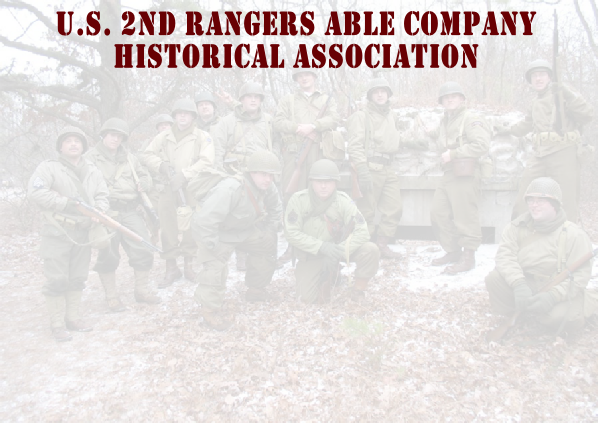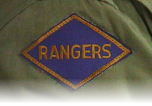



Entire website and contents are copyright ©2016 2nd Rangers Able Company Historical Association all rights reserved.
2nd RANGERS INFANTRY BATTALION:
A, B & C Company’s HISTORY
DESIGNATION & TRAINING.
The 2nd Ranger Infantry Battalion was activated on 1 April 1943 at Camp Forrest,
Tennessee. The 2nd Rangers Battalion consisted of approximately 500 men. There were
six line companies, "A" Company through "F" Company and a Battalion Headquarters
Company. The line companies had two platoons. Each platoon had two rifle sections,
a B.A.R. machine gun and a mortar section. There were 65 men plus 3 officers in each
company. The Rangers had to have the highest physical stamina and superior mental
ability to perform as an outstanding fighting team in order to accomplish any given
mission. They were skillfully trained and were proficient in all types of weapons,
hand-
On November 21, the battalion sailed for England. Early in December 1943, the Rangers arrived in Grenach, Scotland. They were soon to learn about the vigorous training and fighting techniques of the Scottish and British Commandos. Christmas was spent in Bude, Cornwall on the western coast of England. Bude furnished the steep cliffs for training.
In January 1944, they were taught by the Commandos the use of small water-
D-
The 2nd's mission was the toughest, most desperate, and dangerous mission of any
of the D-
The remainder of the Ranger force, companys A, B & C, would wait offshore under the
command of newly promoted Lieutenant Colonel Max Schneider. If the assault force
under Rudder took possession of Pointe-
The plan had been for the 2nd Rangers to hit the base of the cliff at 0630, just
moments after heavy naval suppressive fires were lifted. It was hoped that the Rangers
could scale the cliff before the defenders could reoccupy their defensive positions
after having been driven by the suppressive fires into the protection of underground
bunkers. Unfortunately, that would not be for the Rangers, impacted by heavy seas
and errant navigation, arrived thirty-
Disembarking from their beached boats, Rudder's men, Companys D, E, & F, assaulted across the gradually narrowing strand of land to the base of the cliff. Taking heavy machinegun fire from a position located on their left flank, the Rangers quickly lost fifteen, dead or wounded. Reaching the ropes, the Rangers began their arduous climb up the suspended rigging.
Not anticipating an attack on their position from the sea, the German defenses facing the Rangers were the weakest. As the Rangers climbed, the Germans tossed grenades over the cliff and cut three or four of the ropes. Within five minutes of starting the climb, the first Rangers were secure on top to be followed in another ten minutes by the bulk of the fighting force.
At approximately 0730, the message "Praise the Lord" was broadcast from Pointe-
Atop Pointe-
Patrols were sent out to reconnoiter the area. Following heavy tracks of the missing
artillery pieces for nearly 250 meters down a dirt road, three Rangers located the
six missing cannons. Well camouflaged and prepared to fire on Utah Beach, the weapons
were stocked with piles of ready ammunition and their gun crews were beginning to
reform approximately 100 meters away. Within minutes, all six cannons were destroyed,
along with a nearby ammunition supply point. By 0900, the 2nd Ranger Infantry Battalion
became the first United States forces to accomplish their mission on D-
For the next forty-
Companies A, B & C of the 2nd Ranger Infantry Battalion were attached to the 116th Inf Battalion. C Company 2nd Ranger Infantry Battalion was prepared to land at H+03 minutes in sector Dog Green of Omaha Beach on the far right flank of the assaulting units, only two minutes after the first wave from LCA's via the HMS Prince Charles.
The 2nd Rangers companies along with the 5th Range Battalion rode the channel tides
waiting for Rudder's message from Pointe-
Reports indicated that only one reinforced battalion of the German 716th Infantry Division was defending both the Omaha and Utah Beach sectors. The defenders were believed to be of minimum quality and standard with no reserves available for local counterattacks.
Unfortunately for the attacking force, this assessment was in total error. An experienced German infantry division, the 352nd, had been moved to the coast early that spring and assigned a sector that was inclusive of Omaha Beach. The net result was a doubling of forces in the area, a soldier of higher standard, improved command and control, and a mobile reserve positioned only five miles from the beach.
The Ranger companies of the 2nd Ranger Infantry Battalion approached first. At 0730, Companys A, B & C Rangers hit the shore at the far western edge of Omaha Beach, out of position & spread out along beachhead "Charlie" and "Dog Green" straddling either side of the Vierville Draw, sustaining over fifty percent casualties before they even made the beach. More than two kilometers from the nearest supporting troops, the Rangers were isolated and on their own. Though isolated and without radio communications, the Rangers continued the fight that eventually provided attacking elements the opportunity to force the Vierville Draw.
As the ramps dropped, the German defenders opened fire, unloading on the disembarking Rangers with a heavy concentration of fire. The fires were intense and some Rangers took nearly thirty minutes to struggle through the water to reach the beach. Offshore, Schneider observed the overwhelming struggle and carnage faced by the 2nd Ranger Infantry Battalion companies. Realizing that the landing effort had been "a disaster," he elected not to wastefully throw his battalion away. Ordering the remaining fifteen LCAs to move east down the coastline, he found a quieter, relatively speaking, sector of Dog Red and commenced his assault at 0745.
Enemy resistance had greatly exceeded expectations. By 0830, all landings at Omaha
Beach were halted and Lieutenant General Omar Bradley was seriously considering redirecting
the follow-
Though it would seem at that moment that the Allied war had been lost on Omaha Beach,
there was American resistance and movement. Tanks of the 741st Tank Battalion, the
first to arrive at Omaha, put up a stiff fight despite their inability to get over
the shingle at the beach's edge. Caught between rising waters and German anti-
Under constant machinegun and sniper fire from the bluffs, Gen Norm Cota continued to move about the beachhead, ordering, cajoling, herding, and reorganizing units, telling his soldiers, "Don't die on the beaches, die up on the bluff if you have to die, but get off the beaches or you're sure to die." Locating the Ranger Infantry Battalion's CP, Cota remained standing & asked of the men around him, "What unit is this?"
They replied, "We're Rangers, sir!"
With that, Cota yelled, "Rangers, lead the way off this beach before we're all killed." Thus was born what would eventually become the official motto and mantra of the Rangers..."Rangers Lead the Way"
As events would have it, the Rangers were in the final stages of preparation to break
out of the beachhead when Cota arrived at their location. Moving forward, Corporal
Gale Beccue of B Company and an accompanying private, shoved an M-
Lieutenant Francis W. "Bull" Dawson was tossed on top of a barrier wall by some of his men. Charging through more wire, Dawson destroyed a machinegun nest, cleared trenches of German defenders, and secured prisoners. The lieutenant's efforts inspired the rest to follow. For his actions, Dawson would be awarded the Distinguished Service Cross.
Having breached the main German defenses on the beach, the Rangers then advanced up the bluff, encountering little opposition along the way. However, the push was not without its moment of levity. For a brief period, members of the Headquarters Company donned their chemical protective mask in belief that the heavy smoke from a brush fire might be gas. The cure nearly turned out to be greater than the "disease," for some men nearly suffocated, having forgotten to pull the plug on the front of the mask that allowed air to circulate through it to breath.
Cresting the top, the Rangers were deployed to the left and right flanks and dispatched a unit to move four miles down the road to seize Vierville. To the front lay open fields and a maze of hedgerows from which German machineguns took the Rangers under fire. The failed aerial bombardment earlier that morning would prove to be costly to the attackers. Breaking up into smaller assault groups, the Rangers and other members of the 116th Infantry Regiment who had also made it to the top had to move forward across intermittently open ground to engage and to outflank the enemy defensive positions. The breakout from Omaha Beach had begun.
D-
JULY & AUGUST 1944
After joining forces, they pushed westward toward the villages of Pierre du Mont
and along the coast toward the town of Grandcamp-
SEPTEMBER -
In September 1944 the Rangers were attached to the 8th Infantry Division to assist in clearing out the German resistance on the Crozon Peninsula. After accomplishing other objectives and rescuing 400 American prisoners, the battalion left for Landerneau, France. Later, they moved to Arlon, Belgium by "40 and 8's" via the railroad. arriving there on October 3rd. Shortly thereafter, they moved to Esch Luxembourg and were attached to the 1st Army. They later went to Vossenach, Germany and held the defensive line there and went on innumerable combat and reconnaissance patrols. On November 19th they were moved back to bivouac area in the Huertgen Forest, the whole battalion was alerted on the night of December 6th and moved out during that cold and wintry night to the Brandenberg area in Germany. The Rangers had been called to assault the icy, slippery Hill 400 which was approximately 403 meters (1,322 feet) high and steep, laden with many pill boxes and had the highest OP, overlooking the Schmidt and Roer dams that previous regular infantry attacks had failed to secure, in the Roer Valley for miles around. The Rangers were told to hold their hill for 24 hours or until duly relieved. A patrol from "D" and "F" Companies at 3:00 a.m. was sent to reconnoiter the best plan of attack on the hill as dawn came up. "A", "B", "C", and "E" Companies got into position to secure the town of Bergstein, Germany where Hill 400 was located. December 7th Companies D and F launched an assault on Hill 400 at 7:30 a.m. It was a bloody battle with heavy casualties, but very successful. The Germans repeatedly counter attacked. The various attacks were horrendous with so many heavy artillery barrages and the many resulting tree bursts preceding each counter attack. The hill was held until relieved on or about December 9, 1944.
Maj. George S. William took over the command of the battalion on December 7th. Lt. Col. Rudder took over command of the 109th Regiment of the 28th Infantry Division the same day. The survivors of Hill 400 returned to the bivouac area in the Heurtgen Forest. The "rest" time did not last long as the remnants of the battalion were alerted to move up to defensive positions in Simmerath and were attached to the 78th Infantry Division who were to defend the left flank of the "Battle of the Bulge" as the German offensive became known, which commenced December 16, 1944. Christmas and the New Year came and passed without relief or replacements. Fortunately, the "Battle of the Bulge" was quickly being contained and driven back by the Allies.
JANUARY -
By mid January, Ranger replacements arrived and training began again by veteran Rangers
amidst snow and below-
Firefights and skirmishes were few and far between at this point in time and the
men engaged in the mop-
***The 2nd Ranger Inf. Batt. was deactivated at Camp Patrick Henry on 23 October 1945.***